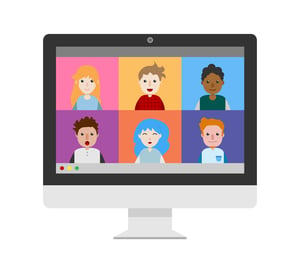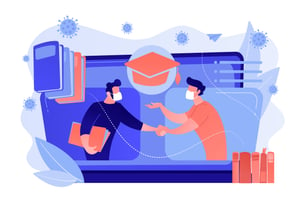- SERVICES
- HIGHER EDUCATION MARKETING
- ENGAGEMENT & ENROLLMENT MANAGEMENT
- STUDENT RECRUITMENT AGENCIES
- PROFESSIONAL EDUCATION & TRAINING
- WHO WE ARE
WHO WE ARE
Learn more about Keystone Education Group, including our leadership structure, why choose Keystone as your educational partner, and company press releases.
QUICK LINKS
- RESOURCES
RESOURCES
Find a range of helpful resources to help with your educational marketing. From on-demand webinars, reports & data, to customer testimonials and our downloadable media kit.
QUICK LINKS
- NEWS
- REQUEST A CALL

- Keystone Higher Education News
- How to integrate work experience into your program
One of the most important aspects of attending university is the experience a student can gain. These days, students are looking not only for excellent classes, but also for great opportunities to build their employability skill sets. For many students, this means internships, and other work related experiences. According to princetonreview.com, “over 75% of employers look for job applicants with hands-on skills in teamwork, problem-solving, and communication.” Therefore, it’s becoming increasingly important for universities to think about ways to integrate work experience into programs. Here are a few things to consider in order to help students take their education to the next level.
Internships:
One of the most tried and true ways universities can help students is by creating internship programs. While many business schools, for example, offer these types of experiences, other programs could benefit from looking into these opportunities as well. Internships are a relevant way for students from all disciplines to really dig in and learn about their chosen profession. In addition to introducing them to their fields, students then have the opportunity to develop the critical skills employers are looking for, while putting their education into action in real time.
Creating an internship program:
Some universities have been in the game for quite a while when it comes to internships, and have been noted for the excellent service they provide to their students. For example, students attending Purdue University are connected to “the state’s startups and early stage companies to provide internship opportunities,” as well as international opportunities.
If your university doesn’t have a large-scale internship program, that’s ok. An internship program is something that can take some time to create, but can be done and done well. A good place to start is by reaching out to your school’s Career Services to see what they already offer. Many schools have databases of internships, or even a designated employee who can help facilitate this process for students. Then, contact various departments to see which disciplines offer internships, and how they’re connecting with their students. This type of cross-discipline collaboration can help open the doors to new internship opportunities for students, and encourage open conversation about how to get the best placements.
Finding internships:
While there’s something to be said for encouraging students to go out and find their own experience, students can also benefit from internship matching. Universities can utilize their databases to help students apply for internships, or can directly connect students with these opportunities. Students can fill out an application, and let the university professional help cross match them with programs. A great way to help develop connections for internships is to reach out to alumni. Many alumni are interested in helping other students, and may have ideas or even internships to offer.
Finally, reach out to the local community. Many industries in local communities have internship or even job opportunities to offer college students, and would like the opportunity to connect. By calling or emailing, it’s possible to create some connections that can lead to chances for students to earn work experience.
Incorporate it into learning:
Making internship hours a requirement for graduation can also encourage students to take gaining work experience during their college years seriously. Bates College in Lewiston, Maine embedded the requirements for work experience into the undergraduate student experience through their Purposeful Work program. By requiring students to have internship hours, but also incorporating it into a curriculum, participating in an internship becomes more accessible, especially for students struggling financially who may not be able to afford an internship experience.
Additionally, good quality internships should be vetted to ensure students are being paid, and having a productive, safe work experience. Internships that aren’t paid should have clear expectations and guidelines for how the student will benefit from participating. Before sending students out into the field, having a university official speak with someone at the internship site or visit can help limit disappointing experiences.
Be flexible:
There are various times when internships take place, but generally it’s broken down by seasons. This usually coordinates with the academic schedule. The University of Washington offers this guidance when it comes to internships, suggesting “the ideal period of internship is one that allows the intern to complete projects that are valuable to both the intern and the employer. It should also allow the intern to get into the rhythm of the job, creating a more realistic experience. The university cites 3-4 months as reasonable, with the intern completing 20-35 hours weekly.”
With that being said, not every student will be able to complete that many hours or weeks. Therefore, it’s important to help students assess their needs, and connect them with internship opportunities that meet those needs.
Going virtual:
The COVID-19 pandemic has changed the way so much is done in the world, and internships are included in this. However, this doesn’t have to be a bad thing, or hold students back from experiencing an internship. As more jobs begin going remote or virtual, students will need the skills that come with these types of jobs to compete in the job market. One of the great aspects about going virtual is it allows for more student flexibility. For students who have tighter schedules, or already have an external workload, the flexibility from an online internship might be just what they need to find success.
For most students work experience is critical when taking their next steps after university. It’s important to help build their resume with desired and critical skills, but they may need guidance to figure out how to get there. By creating an internship program, or encouraging students to participate in one, you’re helping them get the most out of their collegiate experience.
More about:
Related Tags
Just For You
Top Picks
Higher Ed Chats Podcast
Listen to the latest episodes of our Higher Ed Chats Podcast - new format for 2024. Hear from Higher Ed thought-leaders from around the world!

Webinar: Dos & Don'ts of Higher Ed Social Media
.png?width=500&name=Social%20Media%20Webinar%20March%2024%20Banners%20(3).png)
Join our live webinar on 27th March to hear from a panel of Higher Ed Social Media experts.
Subscribe
to get the latest news and updates





